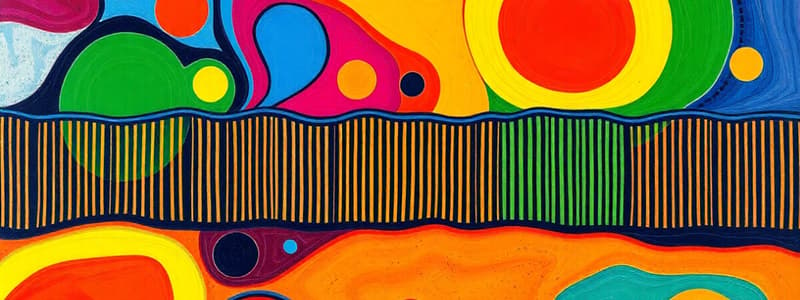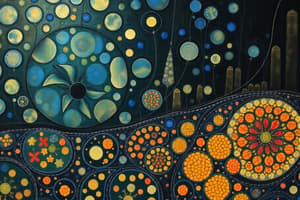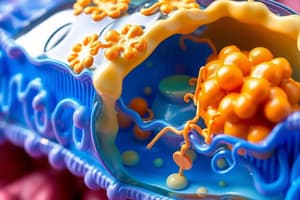Podcast
Questions and Answers
What is the primary function of the sodium-potassium pump?
What is the primary function of the sodium-potassium pump?
- Facilitate the transport of glucose into the cell
- Move both sodium and potassium ions against their concentration gradients (correct)
- Utilize energy from the sodium gradient established by Na/K-ATPase
- Move sodium ions into the cell and potassium ions out of the cell
What type of transport is referred to as secondary active transport?
What type of transport is referred to as secondary active transport?
- Direct ATP-dependent ion movement
- Passive transport relying solely on concentration gradients
- Uphill transport coupled with downhill transport of another substance (correct)
- Movement of molecules without any transport proteins
Which enzyme is responsible for the hydrolysis of ATP in primary active transport?
Which enzyme is responsible for the hydrolysis of ATP in primary active transport?
- H+-ATPase
- Ca2+-ATPase
- GLUT4 transporter
- Na+/K+-ATPase (correct)
Why can't ions like Na+ or Cl- pass through the membrane directly?
Why can't ions like Na+ or Cl- pass through the membrane directly?
What happens when Na+ binds to a transport protein during secondary active transport?
What happens when Na+ binds to a transport protein during secondary active transport?
Which type of molecules can cross the membrane by simple diffusion?
Which type of molecules can cross the membrane by simple diffusion?
What directly influences the rate of diffusion across a membrane?
What directly influences the rate of diffusion across a membrane?
What is a characteristic of facilitated diffusion?
What is a characteristic of facilitated diffusion?
Which type of ion channels responds to mechanical deformation of the membrane?
Which type of ion channels responds to mechanical deformation of the membrane?
What describes passive transport mechanisms?
What describes passive transport mechanisms?
Which factor does NOT affect the rate of diffusion?
Which factor does NOT affect the rate of diffusion?
What kind of molecules typically diffuse through ion channels?
What kind of molecules typically diffuse through ion channels?
What happens to diffusion rates when the temperature increases?
What happens to diffusion rates when the temperature increases?
What structures do phospholipid molecules have in the cell membrane?
What structures do phospholipid molecules have in the cell membrane?
Which type of protein is embedded within the lipid bilayer of the cell membrane?
Which type of protein is embedded within the lipid bilayer of the cell membrane?
What is one of the primary functions of the cell membrane?
What is one of the primary functions of the cell membrane?
How thick is the plasma membrane typically?
How thick is the plasma membrane typically?
What does the fluid mosaic model describe?
What does the fluid mosaic model describe?
What role does the cell membrane play in cell communication?
What role does the cell membrane play in cell communication?
What do peripheral membrane proteins do?
What do peripheral membrane proteins do?
How does the cell membrane contribute to the selective movement of ions?
How does the cell membrane contribute to the selective movement of ions?
What primary mechanism does SGLT1 utilize for glucose reabsorption in the kidney?
What primary mechanism does SGLT1 utilize for glucose reabsorption in the kidney?
Which process describes the movement of molecules into the cell using vesicles?
Which process describes the movement of molecules into the cell using vesicles?
What role does GLUT2 play in glucose transport in the kidney?
What role does GLUT2 play in glucose transport in the kidney?
Which type of endocytosis involves the engulfing of large particles?
Which type of endocytosis involves the engulfing of large particles?
What is one of the functions of exocytosis in cells?
What is one of the functions of exocytosis in cells?
Which of the following statements about SGLT1 is true?
Which of the following statements about SGLT1 is true?
In what way does fluid endocytosis differ from other forms of endocytosis?
In what way does fluid endocytosis differ from other forms of endocytosis?
Which factor is NOT involved in influencing the transport of substances across the cell membrane?
Which factor is NOT involved in influencing the transport of substances across the cell membrane?
Flashcards
Passive Transport
Passive Transport
Movement of substances across a cell membrane without requiring energy. This type of transport occurs down a concentration gradient, from a region of high concentration to a region of low concentration.
Active Transport
Active Transport
Movement of substances across a cell membrane requiring energy. It occurs against a concentration gradient, from a region of low concentration to a region of high concentration.
Primary Active Transport
Primary Active Transport
Active transport that directly utilizes ATP for energy. This type of transport uses transport proteins to move substances against their concentration gradients.
Sodium-Potassium Pump
Sodium-Potassium Pump
Signup and view all the flashcards
Secondary Active Transport
Secondary Active Transport
Signup and view all the flashcards
Diffusion
Diffusion
Signup and view all the flashcards
Factors affecting diffusion rate
Factors affecting diffusion rate
Signup and view all the flashcards
Simple Diffusion
Simple Diffusion
Signup and view all the flashcards
Facilitated Diffusion
Facilitated Diffusion
Signup and view all the flashcards
Ion Channels
Ion Channels
Signup and view all the flashcards
Types of Ion Channels
Types of Ion Channels
Signup and view all the flashcards
Voltage-gated Ion Channels
Voltage-gated Ion Channels
Signup and view all the flashcards
Ligand-gated Ion Channels
Ligand-gated Ion Channels
Signup and view all the flashcards
SGLT1: What is it?
SGLT1: What is it?
Signup and view all the flashcards
How does SGLT1 work in the kidney?
How does SGLT1 work in the kidney?
Signup and view all the flashcards
What is the difference between symport and antiport?
What is the difference between symport and antiport?
Signup and view all the flashcards
What is the cell membrane?
What is the cell membrane?
Signup and view all the flashcards
What is secondary active transport?
What is secondary active transport?
Signup and view all the flashcards
What is the role of GLUT2 in glucose transport?
What is the role of GLUT2 in glucose transport?
Signup and view all the flashcards
What is the fluid mosaic model?
What is the fluid mosaic model?
Signup and view all the flashcards
What does the cell membrane regulate?
What does the cell membrane regulate?
Signup and view all the flashcards
What is Endocytosis?
What is Endocytosis?
Signup and view all the flashcards
What are transmembrane proteins?
What are transmembrane proteins?
Signup and view all the flashcards
What are the different types of Endocytosis?
What are the different types of Endocytosis?
Signup and view all the flashcards
What is the difference between integral and peripheral membrane proteins?
What is the difference between integral and peripheral membrane proteins?
Signup and view all the flashcards
What is Exocytosis?
What is Exocytosis?
Signup and view all the flashcards
Why is the cell membrane selectively permeable?
Why is the cell membrane selectively permeable?
Signup and view all the flashcards
What are the main functions of the cell membrane?
What are the main functions of the cell membrane?
Signup and view all the flashcards
What is the significance of maintaining different compositions between ICF and ECF?
What is the significance of maintaining different compositions between ICF and ECF?
Signup and view all the flashcards
Study Notes
Membrane Transport Processes
- The cell membrane is a selectively permeable barrier separating intracellular fluid (ICF) from extracellular fluid (ECF).
- ECF and ICF have different compositions, requiring substance exchange.
- Objectives include understanding the cell membrane's structure, properties affecting transport, and various transport mechanisms.
- The fluid mosaic model describes the membrane's dynamic nature with embedded proteins and a phospholipid bilayer.
- The bilayer consists of hydrophilic heads attracted to water (cytoplasm, ECF) and hydrophobic tails, attracted to other lipids.
- Proteins embedded in or associated with the membrane, help move substances across the membrane.
- Substances can cross the membrane via passive or active mechanisms.
Cell Membrane Structure
- The cell membrane is a bilayer approximately 6-10nm thick.
- Electron microscopy is needed to visualize it.
- The membrane separates the cell's contents from its surroundings, controlling substances entering and leaving the cell and between organelles.
- It detects chemical messengers and links adjacent cells.
- It anchors cells to the extracellular matrix.
Phospholipid Bilayer
- Phospholipids have a glycerol head and two fatty acid tails.
- The hydrophilic head interacts with water; the hydrophobic tails do not.
- This bilayer structure creates a barrier to water-soluble substances.
Proteins in the Cell Membrane
- Integral proteins span the entire membrane; anchored to the hydrophobic tails.
- Some proteins span the entire membrane, interacting with both ICF and ECF.
- Examples include receptors and transport proteins.
- Peripheral proteins are loosely associated with the membrane by hydrophobic interactions.
Cell Membrane as a Barrier
- The membrane is selectively permeable, allowing some substances to pass freely whereas others cannot.
- Lipid-soluble and small polar substances can passively diffuse across.
- Large polar substances and ions need help via channels or carrier proteins.
- Factors affecting diffusion rate include concentration gradient steepness and temperature.
Passive Transport
- Passive transport moves substances down a concentration gradient, requiring no energy input.
- Simple diffusion: substances move directly through the membrane (lipid-soluble substances, gases).
- Facilitated diffusion: substances use channels or carrier proteins to cross the membrane; important for larger or non-lipid soluble molecules.
Active Transport
- Active transport moves substances against a concentration gradient, requiring energy (ATP).
- Primary active transport directly uses ATP to move substances, e.g., the sodium/potassium pump.
- Secondary active transport uses the electrochemical gradient created by primary active transport to move other substances as well.
Endocytosis and Exocytosis
- Endocytosis: the uptake of molecules into the cell via vesicles.
- Exocytosis: the release of molecules from the cell via vesicles.
- Different types of endocytosis include fluid endocytosis (pinocytosis), phagocytosis, and receptor-mediated endocytosis.
Ion Channels
- Ion channels are protein subunits, specific to particular ions, and exist in open or closed states.
- Voltage-gated channels open/close in response to changes in voltage.
- Ligand-gated channels open/close in response to binding ligands.
- Mechanosensitive channels respond to physical forces.
Summary of Concepts
- Passive transport substances move with the concentration gradient e.g. diffusion
- Active transport substances move against the concentration gradient e.g. pumps
- Different transport systems exist to support various molecules
- Membrane transport is key to cellular function
Studying That Suits You
Use AI to generate personalized quizzes and flashcards to suit your learning preferences.




